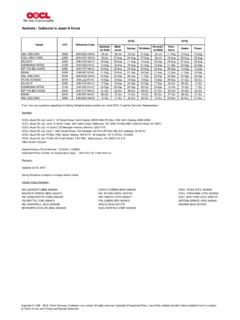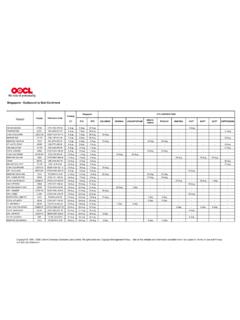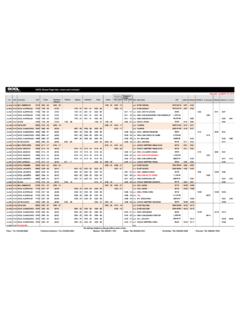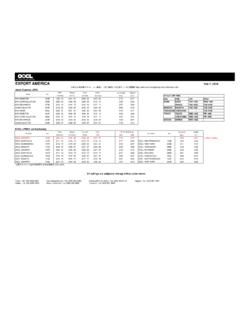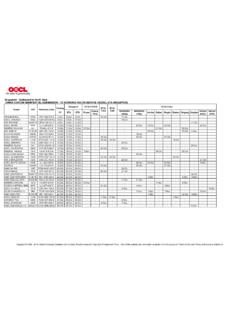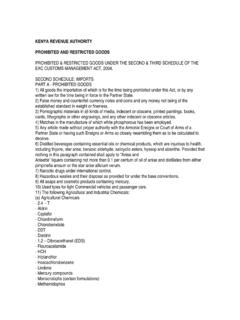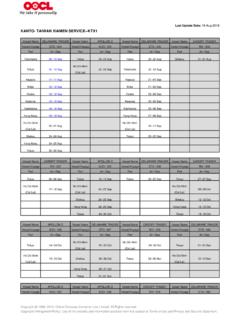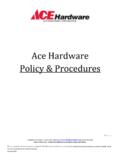Transcription of BNSF Intermodal Loading Guide - OOCL
1 bnsf Intermodal Loading GuideLoad and Ride Solutions Team ( LARS )TABLE OF CONTENTS SECTION I General Information SECTION II Trailer/Container Inspection Procedures SECTION III TOFC/COFC Physical Environment SECTION IV Loading , Blocking & Bracing of Intermodal Loads SECTION V LTL, Planning & Loading SECTION VI Dunnage & Unitizing Materials SECTION VII bnsf Approved Methods 1. Rear Door Method 2. Cased Goods (Food & Beverages) 3. Paper (Rolls, Flat Stock & Bales) 4. Metal Products 5. Drum Loading 6. Construction Materials 7. Logs 8. LTL Shipments 9. Motor Vehicles & Fork Lift Trucks 10. Plate Glass & Glass Bottles 11. Ceramic Tile & Carpeting 12. Plastic Bulk Tanks SECTION VIII Restricted Commodities SECTION IX Vendor Listings SECTION IGENERAL INFORMATIONGENERAL INFORMATIONAs a " Intermodal " shipper on the bnsf , you've selected the number one TOFC/COFC carrier in the industry -- both in volume andcommitment.
2 At the bnsf we are committed to meet the challenges of the future in both service and equipment bnsf our number one priority is the safety of our employees, the communities through which we operate, and the cargo that isentrusted to us by our customers. "Our vision is to realize the tremendous potential of the Burlington Northern Santa Fe Railway by providing transportation services that consistently meet our customers expectations."SAFE LOADINGW hile bnsf goes to great lengths to provide top-notch service for our customers, .Should a load shift occur, due to improper weightdistribution or inadequate blocking and bracing, the vehicle may lean excessively on the flatcar, or lading may burst through either endof the vehicle. A leaning vehicle, because of its high center of gravity, can actually fall from the flatcar or cause flatcar wheels toraise from the track, either of which can result in a serious derailment.
3 Lading moving against vehicle doors can break door lockingmechanisms, allowing doors to open and lading to fall from the vehicle. Either of these instances can cause personal injury, as wellas damage to both equipment and your products. DISTRESSED VEHICLE SETOUT EN ROUTEW hile in transit, if the vehicle is observed leaning or with distressed doors, the train is stopped, the load is setout for adjustment andforwarded to destination. This results in delays to other shipments in train, as well as your publication has been developed to prevent such mishaps. By following basic rules of tight Loading , proper weight distribution andadequate blocking and bracing, your load will arrive in damage-free condition for your you are a new customer, have a Loading problem or an alternative Loading method for evaluation, contact your local Load and Ride Solutions Manager.
4 To obtain further information please reference the bnsf Rule & Policies Guide or your Account IITRAILER/CONTAINERINSPECTION PROCEDURESTRAILER/CONTAINER INSPECTION PROCEDURESB efore ordering equipment you will want to consider many factors, Loading and unloading facilities and systems,maximizing equipment capacity, as well as complying with all applicable transport regulations. You will alsoneed to determine if any special equipment requirements ( , insulated trailers, temperature control, specialinterior fixtures, etc.) are needed for each load prior to ordering dock access is available at origin and destination, and goods are palletized, closed vans should be the propertype of equipment to order. If lading is of extreme length, and loaded form the side or with an overhead crane, anopen-top or flatbed vehicle should be and dimension of lading for shipment will dictate size and type of vehicle to order.
5 The load weight limitof the vehicle must not be exceeded, however, regardless of the amount of cubic capacity taken up by the load weight limit of the vehicle can be determined by consulting the manufacturer's specification plate on thevehicle, the Official Intermodal Equipment Register or the equipment regulations regarding load limits over routes the shipment will move must be considered in loadpreparation; the same as vehicle weight limits. In instances were vehicle and highway limits vary, the lowerweight limit will govern the amount of lading to be shipped in a single vehicle. Under no circumstances should aload in excess of 65,000 pounds gross weight be tendered for appropriate equipment has been ordered, perform a through exterior and interior inspection prior toaccepting the equipment for INSPECTIONThe exterior inspection should include these items:1) Checking safety appliances to assure compliance with highway ) Checking for defects that could affect sealing qualities of vehicle, such as bent or broken doors, damaged ormissing weather seals, defective locking hardware, ) Examination of vehicle walls, roof panels, top rail and undercarriage for soundness and holes, cuts, bends,dents or other defects which could allow entrance of the INSPECTIONThe interior inspection should include the following.
6 1) Checking for foreign materials or odors which might be contaminating to your ) Checking wall and door linings for broken or missing panels, and for nails, staples or other protrusionswhich could contact lading and cause damage. If any such defects are found, you may elect to cover thedefective area(s) with corrugated fibreboard or other suitable material, remove protruding objects, or rejectthe vehicle for ) Examination of floor for soundness, particularly where bracing materials will be nailed to ensure the nail smaximum holding power. Remove any exposed nails or protrusions. Sweep the vehicle floor before loadingto minimize dust settling on lading during ) Checking for leaks. If your product is susceptible to damage from the elements, get inside the vehicle andhave the doors closed and latched.
7 If light enters the vehicle, so can moisture, air and dust. After dark,check by using a spotlight around outside of vehicle, and along all seams. If defects are found, reject thevehicle for IIITOFC/COFCPHYSICAL ENVIRONMENTTHE RAIL ENVIRONMENTI ntermodal customers should be aware of the physical forces that affect the load during transit. Since the shipmentwill travel by truck, rail, and possibly water or air modes, the individual operations and physical characteristics ofeach should be considered, as well as the combined effects. By understanding the forces affecting each shipmentin various modes, the most effective packaging, load planning, blocking and bracing for safe arrival can and shock are two forces encountered in transport. The forces occur continuously (vibration, a result ofan object oscillating) as isolated incidents (shock, a result of an abrupt change in acceleration and direction) orsimultaneously, which results in very complex dynamic forces.
8 These forces generally occur in three directions:vertical, longitudinal and to control (dampen) these elements can jeopardize the safe transportation of the load, as well as the entiretrain. Improperly loaded freight or inadequate bracing can produce the following situations:1) load movement to one side of the vehicle, causing it to lean excessively on the ) load movement through the ends of the vehicle3) collapsed vehicle floors (from concentrated weight of high-density commodities or poor condition ofvehicle).Any of these situations can cause lading damage from compression; damage to equipment doors, walls or floor; orcause a train HIGHWAY ENVIRONMENTV ibration in the vertical direction is considered most severe in the highway environment. This is a result of thetruck's suspension system having a natural response in a low-frequency range.
9 When the vehicle tires contact thehighway surface, a continuous vertical vibration input (forcing frequency) is produced. Uneven surfaces, such asholes, bridge abutments or grade crossings, produce vertical shocks, which also produce vertical vibrations. Whenthe forcing frequency coincides with the natural frequency of the suspension system, amplification of the forcesoccur. At times, these amplified forces can reach such magnitude that even high-density lading will move, oftennecessitating a load forces generated from traversing uneven roadway surfaces normally are not as severe as vertical shocks encountered in the highway mode during starting and stopping in traffic, or backing into adock, are generally greater as those experienced in the rail optimal ride quality is found in the center portion of the vehicle, followed by the nose portion and then therear area.
10 SECTION IVLOADING, BLOCKING ANDBRACING OF INTERMODALLOADS Loading , BLOCKING AND BRACING Intermodal LOADSWhen shipping Intermodal on the bnsf , the shipper has certain obligations to safely load contents, as stated in TheBNSF Intermodal Rules & Policies Guide . These obligations are:1) In no instance can gross weight of vehicles and contents exceed 65,000 pounds. Responsibility for adequatepackaging, Loading , blocking and bracing of the shipment lies entirely with the ) Weight Distribution: Vehicles are designed for uniform load distribution. Lading weight in vehicles mustbe evenly distributed both crosswise and lengthwise. It must be equally distributed between the rear tiresand the kingpin. Lading is to be secured in such a manner to prevent it from shifting either crosswise orlengthwise during transport where it would affect safe weight distribution or position in ) When Loading heavy or concentrated weight commodities no more than 25,000 pounds may be uniformlydistributed over any 10 lineal feet within the vehicle.

